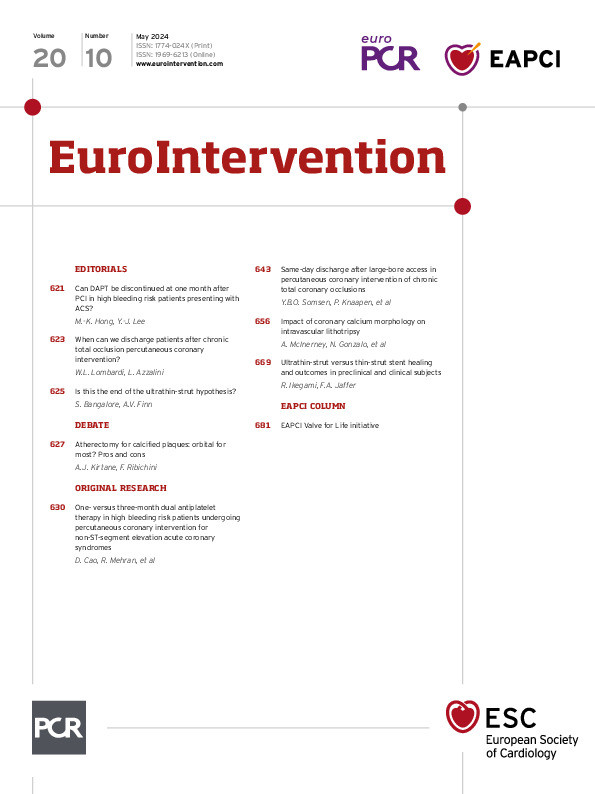Implementing same-day discharge (SDD) after elective percutaneous coronary intervention (PCI) is associated with important cost savings1 and might also improve patient flow through the hospital. SDD has been steadily growing in certain environments (e.g., approximately one-third of elective PCIs in the USA in 20172), in parallel with the adoption of radial access12. The introduction of SDD has not correlated with worse overall clinical outcomes12, indicating its safety in specific scenarios. There seems to be a large between-hospital variation in SDD rates12, suggesting the existence of logistical and clinical practice-related barriers to a homogeneous adoption of SDD.
Chronic total occlusion (CTO) PCI has witnessed a remarkable growth over the past decade. Implementing an SDD strategy after CTO PCI is appealing for the same reasons as after PCI in all-comers, yet its implementation is hampered by unique challenges, including higher use of femoral access, contrast volume, and risk of procedural complications.
Small single-centre studies from the USA3 and Greece4 recently reported on the feasibility of SDD after CTO PCI. SDD was adopted in 41.7% and 29.5% of patients, respectively, and was employed more frequently if the retrograde approach was not used, the procedure was completed before 17:003, and a forearm access was exclusively utilised4. At 30 days, major adverse cardiac event (MACE) rates were low and similar between SDD and overnight observation (OO) patients34. These findings were confirmed in an international registry including 7,181 patients by Simsek et al5 who observed that the SDD rate increased from 3% in 2015 to 21% in 2022. While increasing procedure time was associated with OO, radialâonly access had the strongest association with SDD. Among patients with SDD, only 2 (0.4%) were readmitted.
In this issue of EuroIntervention, Somsen et al6 report on their single-centre experience with SDD after CTO PCI. SDD was observed in 61.5% of 948 cases performed at a high-volume Dutch centre over the course of a decade. Large-bore access (≥7 French) was used in 99% of the cohort, and >99% of patients had at least one femoral access. Vascular closure devices were used in 99% of femoral cases. Technical (95% vs 87%) and procedural (95% vs 77%) success rates were higher in SDD versus OO patients (p<0.01 for both). The most common causes for deciding to pursue OO were hypotension, side-branch occlusion, and persisting chest pain (collectively, 30%), bleeding (22%), and MACE (16%). Rates of MACE (0.9% vs 22.7%; p<0.01) and other complications (e.g., access-site bleeding 4.3% vs 29.0%; p<0.01) were markedly lower in the SDD group. On multivariable analysis, male sex, renal insufficiency, prior myocardial infarction and coronary artery bypass grafting, technical failure, access-site bleeding, and vascular complications were independent predictors of OO. At 30 days, hospital readmission rates were 5.3% versus 7.1% (p=non-significant) in SDD versus OO. SDD was not a predictor of MACE or readmission at 30-day follow-up.
The authors are to be congratulated for sharing such a meticulous analysis and systematically tracking their CTO PCI outcomes. In particular, the current study contributes important data on the safety of pursuing SDD even in case of liberal use of the transfemoral approach with large-bore sheaths (~99% in the SDD group). Also, this cohort is currently the one with the highest reported use of an SDD strategy (61.5%) compared with previous literature (13.1%-41.7%345) and stands as an example of a “win-win” scenario where patient safety and comfort are ensured while hospital bed flow is optimised and healthcare costs are reduced.
In our practice (a large quaternary hospital with one of the largest CTO programmes on the continent), SDD is also frequently employed (45.6% in 2023). Factors to consider for the safe application of an SDD strategy are outlined in Table 1. Importantly, these are not exclusively based on the patients’ clinical profile or procedural outcome, they also involve state-of-the-art nursing supervision in the post-Âprocedural recovery area, as well as logistical considerations (e.g., the patient must be able to swiftly return to the hospital in case of a complication soon after discharge).
However, despite the relevant findings provided by Somsen et al6 and other studies that have characterised the patient/procedure profile suitable for SDD after CTO PCI345, the clinician still lacks practical tools to identify scenarios best suited for SDD. From this perspective, we are eagerly awaiting the development and prospective validation of a risk score able to identify candidates for SDD after procedure completion. Moreover, to further affect a change towards SDD in conservative healthcare systems that are adopting OO in most/all cases, data from cost-effectiveness analyses quantifying cost savings with SDD are needed.
In the meantime, we will use the findings by Somsen et al6 as well as previous literature345 to guide our decision-making regarding this important clinical question.
Table 1. Suggested criteria for a safe same-day discharge
| No procedural complication |
| Absence of severe chronic kidney disease |
| No access-site bleeding or vascular complications during 6 h of post-PCI observation |
| Patent haemostasis with early (2 h) radial compression device removal; liberal use of vascular closure devices |
| Early ambulation (2 h after radial/femoral sheath removal) |
| Patient lives within a 30-minute drive or plans to stay overnight in the vicinity of the hospital |
Conflict of interest statement
W.L. Lombardi has received consulting fees from Asahi Intecc, Abiomed, Boston Scientific, Medtronic, Siemens, and Teleflex; has received royalties from Asahi Intecc; owns equity in Reflow Medical; and his spouse is a Reflow Medical employee. L. Azzalini has received consulting fees from Teleflex, Abiomed, GE HealthCare, Abbott, Reflow Medical, and Cardiovascular Systems Inc; has served on the advisory board of Abiomed and GE HealthCare; and owns equity in Reflow Medical.

